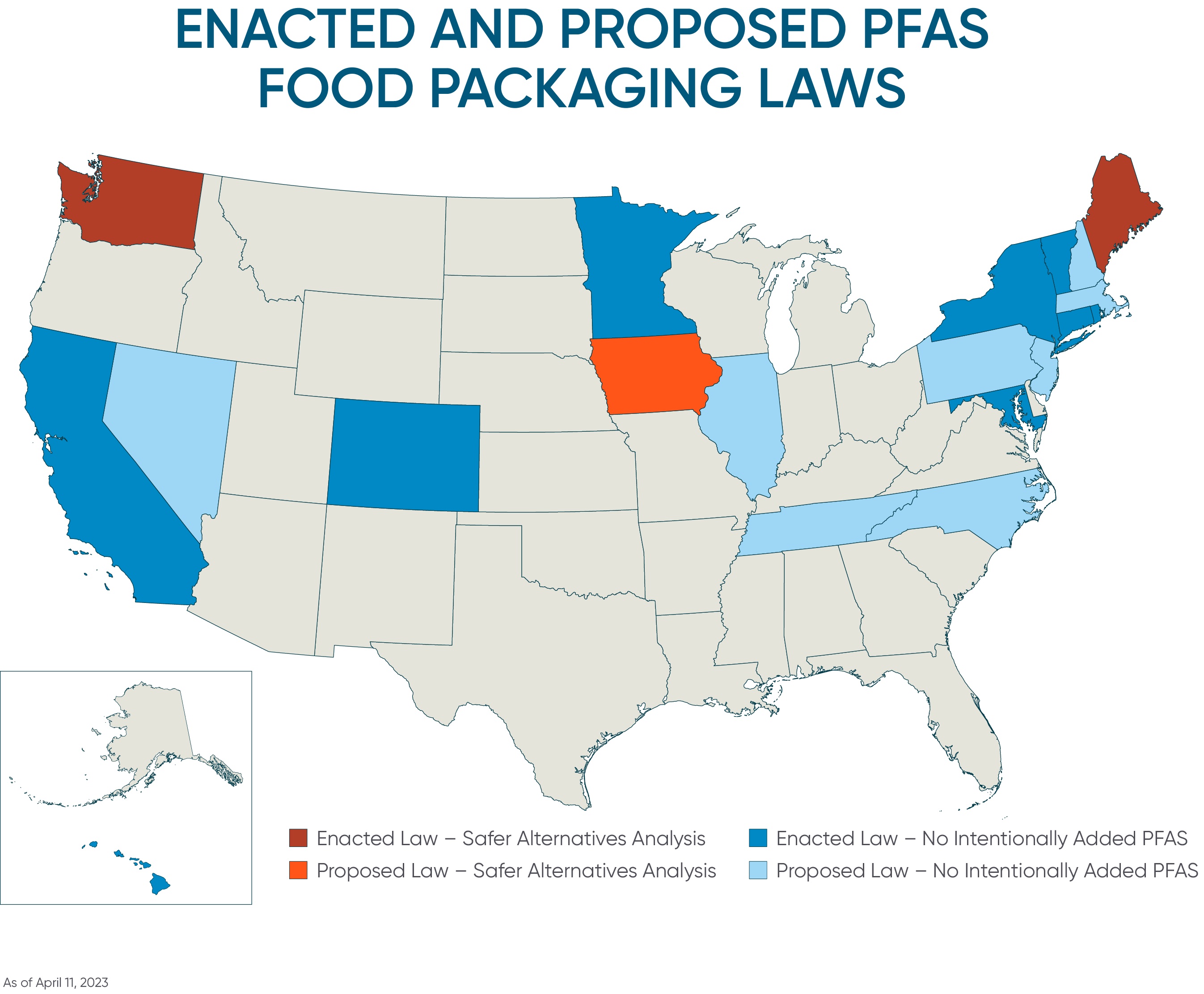Insights
PFAS Update: State Regulation of PFAS in Food Packaging - April 2023
Apr 13, 2023This blog was originally published in April 2023. Visit our up-to-date blog on PFAS in food packaging: state-by-state regulations >
In the absence of comprehensive federal regulation of PFAS in food packaging, states are dishing out their own laws. Thus far, eleven states have enacted laws concerning PFAS substances in food containers and packaging materials (“Food Packaging”), and there are proposed laws currently pending in nine other states. These laws are intended to address concerns that storing food in Food Packaging which contains PFAS compounds may result in increased ingestion of those PFAS compounds.
According to the Agency for Toxic Substances and Disease Registry (“ATSDR”), commonly cited examples of Food Packaging that have historically contained PFAS compounds include “some grease-resistant paper, fast food containers/wrappers, microwave popcorn bags, pizza boxes, and candy wrappers.”
State Food Packaging Laws
In response to this perceived health risk, states have enacted and proposed a variety of different laws to curtail the use of PFAS in food packaging. In terms of the type of regulatory approach, states have generally adopted either a safer alternatives framework, or a prohibition on intentionally added PFAS. With respect to the scope of “food packaging” that is subject to the state laws, some states have limited the definition to plant or fiber-based food packaging, while other states have included all food packaging.
The one constant in the variety of regulatory approaches seems to be the incredibly broad definition of PFAS, which is universally “fluorinated organic chemicals containing at least one fully fluorinated carbon atom.” This map and the following chart provide a more detailed analysis of each state’s regulatory approach, and is current as of April 11, 2023.

Enacted Law - no intentionally added PFAS |
|
Effective date
January 1, 2023
Food Packaging Description
No person shall distribute or sell any food packaging that either has:
- PFAS that are intentionally added to a product and that have a functional or technical effect in the product; or
- More than 100 ppm of PFAS substances as measured in total organic fluorine.
“Food packaging” is defined as “a nondurable package, packaging component, or food service ware that is intended to contain, serve, store, handle, protect, or market food, foodstuffs, or beverages, and is comprised, in substantial part, of paper, paperboard, or other materials originally derived from plant fibers.”
“Food packaging” includes food or beverage containers, take-out food containers, unit product boxes, liners, wrappers, serving vessels, eating utensils, straws, food boxes, and disposable plates, bowls, or trays.
Packaging Distinction
Plant-based food packaging
Regulatory Status
Enacted
Details
AB 347 (Proposed Bill Involving Enforcement and Penalty Provisions)
Effective date
January 1, 2024
Food Packaging Description
No person shall sell or distribute any product in the food packaging category if the product contains intentionally added PFAS substances.
"Food packaging" is defined as “a package or packaging component used in direct contact with food and that is composed, in substantial part, of paper, paperboard, or other materials originally derived from plant fibers.”
Packaging Distinction
Plant-based food packaging
Regulatory Status
Enacted
Details
Effective date
January 1, 2024
Food Packaging Description
No food package to which PFAS substances are intentionally introduced in any amount during manufacturing or distribution shall be offered for sale or for promotional purposes by its manufacturer or distributor.
"Food packaging" is defined as “any package or packaging component that is applied to or in direct contact with any food or beverage.”
Packaging Distinction
All food packaging
Regulatory Status
Enacted
Details
Effective date
December 31, 2024
Food Packaging Description
It is unlawful to manufacture, sell, or distribute certain food packaging (specifically wraps and liners, plates, food boats, and pizza boxes) to which PFAS chemicals have been intentionally introduced in any amount.
"Food packaging" is defined as “a package or packaging component that is applied to or in direct contact with any food or beverage and is comprised, in substantial part, of paper, paperboard, or other materials originally derived from plant fibers.”
Packaging Distinction
Plant-based food packaging
Regulatory Status
Enacted
Details
Effective date
January 1, 2024
Food Packaging Description
A manufacturer or distributor may not manufacture, distribute, or sell a food package to which PFAS substances have been intentionally added.
“Food package” means a package that is designed and intended for direct food contact and is composed, in substantial part, of paper, paperboard, or other materials originally derived from plant fibers, including: (1) a food or beverage product that is contained in a food package or to which a food package is applied; (2) a packaging component of a food package; and (3) plastic disposable gloves used in commercial or institutional food service.”
Packaging Distinction
Plant-based food packaging
Regulatory Status
Enacted
Details
Effective date
January 1, 2024
Food Packaging Description
No person shall manufacture, sell, distribute, or offer for use a food package that contains intentionally added PFAS.
"Food package" is defined as “a container applied to or providing a means to market, protect, handle, deliver, serve, contain, or store a food or beverage.”
Food package includes: “(1) a unit package, an intermediate package, and a shipping container; (2) unsealed receptacles, such as carrying cases, crates, cups, plates, bowls, pails, rigid foil and other trays, wrappers and wrapping films, bags, and tubs; and (3) an individual assembled part of a food package, such as any interior or exterior blocking, bracing, cushioning, weatherproofing, exterior strapping, coatings, closures, inks, and labels.”
Packaging Distinction
All food packaging
Regulatory Status
Enacted
Details
Effective date
December 31, 2022
Food Packaging Description
No person shall distribute or sell food packaging containing PFAS substances as intentionally added chemicals.
"Food packaging" is defined as “a package or packaging component that is intended for direct food contact and is comprised, in substantial part, of paper, paperboard, or other materials originally derived from plant fibers.”
“Intentionally added chemical” is defined by a separate statute as a “chemical in a product that serves an intended function in the product component.”
Packaging Distinction
Plant-based food packaging
Regulatory Status
Enacted
Details
S 8817 and 37-0901 (definitions)
New York Department of Environmental Conservation Information
Effective date
January 1, 2024
Food Packaging Description
No manufacturer or distributor shall sell a food package in which PFAS substances have been intentionally introduced in any amount.
"Food packaging" is defined as “any package or packaging component that is applied to or in direct contact with any food or beverage.”
"Intentional introduction of PFAS" is defined as:
“(1) deliberately utilizing PFAS in the formulation of a package or packaging component where its continued presence is desired in the final package or packaging component to provide a specific characteristic, appearance, or quality;
(2) the use of a regulated chemical as a processing agent, mold release agent or intermediate is considered intentional introduction for the purposes of this chapter where the regulated chemical is detected in the final package or packaging component or
(3) the use of post-consumer recycled materials as feedstock for the manufacture of new packaging materials, where some portion of the post-consumer package or packaging component may contain amounts of the regulated chemicals but is neither desired nor deliberate, is not considered intentional introduction for the purposes of this chapter where said final package or packaging component is in compliance with § 23-18.13-4(d).”
Packaging Distinction
All food packaging
Regulatory Status
Enacted
Details
Effective date
July 1, 2023
Food Packaging Description
A manufacturer, supplier, or distributor shall not manufacture, sell, or distribute a food package to which PFAS substances have been intentionally added and are present in any amount.
“Food package” or “food packaging” means a package or packaging component that is intended for direct food contact.
“Package” is defined as “a container providing a means of marketing, protecting, or handling a product and shall include a unit package, an intermediate package, and a shipping container. Package also means unsealed receptacles, such as carrying cases, crates, cups, pails, rigid foil and other trays, wrappers and wrapping films, bags, and tubs.”
“Packaging component” is defined as “an individual assembled part of a package, such as any interior or exterior blocking, bracing, cushioning, weatherproofing, exterior strapping, coatings, closures, inks, and labels, and disposable gloves used in commercial or institutional food service.”
Packaging Distinction
All food packaging
Regulatory Status
Enacted
Details
proposed Law - no intentionally added PFAS |
|
Effective date
December 31, 2026
Food Packaging Description
It shall be unlawful to manufacture, sell, or distribute any food packaging that contains intentionally added PFAS, subject to some exceptions.
Packaging Distinction
All food packaging
Regulatory Status
Proposed
Details
Effective date
January 1, 2025
Food Packaging Description
No person shall sell or distribute food packaging if it contains an intentionally added PFAS.
“Food Packaging” " is defined as “a package or packaging component that is applied to or in direct contact with any food or beverage and is comprised, in substantial part, of paper, paperboard, or other materials originally derived from plant fibers.”
Packaging Distinction
Plant-based food packaging
Regulatory Status
Proposed
Details
Effective date
January 1, 2025
Food Packaging Description
No person or entity shall manufacture, sell, or distribute food packaging to which PFAS substances have been intentionally added in any amount.
“Food package" is defined as “a package or packaging component that is intended for the marketing, protection or handling of a product intended for food contact or used to store food and foodstuffs for sale.”
Packaging Distinction
All food packaging
Regulatory Status
Proposed
Details
Effective date
January 1, 2024
Food Packaging Description
Manufacturers shall not sell or distribute food packaging if the product contains intentionally added PFAS substances.
“Food Packaging” is defined as “a package or packaging component that is used in direct contact with food and is composed of, in substantial part, paper, paperboard or other materials originally derived from plant fibers.”
Packaging Distinction
Plant-based food packaging
Regulatory Status
Proposed
Details
Effective date
January 1, 2024
Food Packaging Description
No food business shall sell or distribute disposable food service products for foods or beverages that contain PFAS substances.
"Disposable food service product" is defined as “food containers designed for one-time use. Disposable food service container includes service ware for beverages, trays, take-out foods, packaged meat, eggs, bakery products, and leftovers from partially consumed meals prepared by food vendors.”
"Food service business" is defined as a “business that sells or provides food for consumption on or off the premises, and includes, but is not limited to, any restaurant, cafe, delicatessen, coffee shop, supermarket or grocery store, vending truck or cart, food truck, movie theater, school, business, or institutional cafeteria, including those operated by or on behalf of the state. Food service business does not include health care facilities or Meals on Wheels programs.
Packaging Distinction
All food packaging
Regulatory Status
Proposed
Details
Effective date
Two years after the effective date of the legislation
Food Packaging Description
No person shall sell or distribute any food packaging that contains an intentionally added PFAS substance unless it “contains a technically unavoidable trace quantity of PFAS, which stems from impurities of natural or synthetic ingredients or the manufacturing process, storage, or migration from packaging of the product.”
“Food Packaging” is defined as “a nondurable package, packaging component, or food service ware that is intended to contain, serve, store, handle, protect, or market food, foodstuffs, or beverages, and is composed, in substantial part, of paper, paperboard, or other materials originally derived from plant fibers.”
“Food packaging” includes food or beverage containers, take-out food containers, unit product boxes, liners, wrappers, serving vessels, eating utensils, straws, food boxes, and disposable plates, bowls, or trays.
Packaging Distinction
Plant-based food packaging
Regulatory Status
Proposed
Details
Effective date
October 1, 2025
Food Packaging Description
No person may manufacture, distribute, sell, export, or use any packaging material containing a PFAS substance.
“Packaging material” is defined as “any part of a package or container, regardless of recyclability or compostability, including material types such as paper, plastic, glass, or metal, that is used for the containment, protection, handling, delivery, transport, distribution, and presentation of a product that is sold, offered for sale, or distributed in North Carolina. Bags are included within this definition.”
Packaging material does not include any of the following: (a) Material intended to be used for long-term storage or protection of a durable product that can be expected to be usable for that purpose for a period of at least five years; (b) Medical devices and packaging that are included with products regulated as a drug, medical device, or dietary supplement under the FDA; and (c) Packaging products used to contain substances hazardous to the environment, regulated under FIFRA.
Packaging Distinction
All food packaging (and all other packaging)
Regulatory Status
Proposed
Details
Effective date
January 1, 2024
Food Packaging Description
No person shall distribute, sell, or offer for sale food packaging containing PFAS substances in any amount.
"Food packaging” is defined as “a container or component that is intended for direct food contact.”
Packaging Distinction
All food packaging
Regulatory Status
Proposed
Details
Effective date
July 1, 2028
Food Packaging Description
A person shall not sell or distribute any packaging designed to include PFAS substances.
"Packaging materials" is defined as “means, regardless of recyclability, a part of a package or container, including material that is used for the containment, protection, handling, delivery, and presentation of a product that is sold, offered for sale, imported, or distributed in this state; and includes: (i) Primary, secondary, and tertiary packaging intended for the consumer market; and (ii) Service packaging designed and intended to be filled at the point of sale, including carry-out bags, bulk goods bags, and take-out and home delivery food service packaging.”
Packaging Distinction
All food packaging
Regulatory Status
Proposed
Details
proposed Law - Safer Alternatives Analysis |
|
Effective date
January 1, 2024
Food Packaging Description
Prohibits the manufacture, sale, and distribution of food packaging where PFAS substances are intentionally added in any amount, but it does not apply to new food packaging. The bill does not apply to food packaging that was either imported or otherwise acquired prior to January 1, 2024. The Iowa Department of Public Health (“DPH”) will conduct a one-year study investigating PFAS substances in food packaging and will attempt to identify safer alternative food packaging materials. DPH must submit a report presenting its findings by December 31, 2024.
“Food Packaging” is defined as a “package, including a unit package, intermediate package, or shipping container, or a packaging component, including any interior or exterior blocking, bracing, cushioning, weatherproofing, exterior strapping, coating, closure, ink, or label, that is intended for the marketing, protection, or handling of a product intended for food contact or used to store food for sale.”
Packaging Distinction
All food packaging
Regulatory Status
Proposed
Details
Enacted Law - Safer Alternatives Analysis |
|
Effective date
Two years following the date on which the MDEP determines that a safer alternative is available, and January 1, 2030
Food Packaging Description
The Maine Department of Environmental Protection (“MDEP”) is permitted to enact rules that prohibit a manufacturer, supplier, or distributor from offering for sale or for promotional purposes a food package to which PFAS substances have been intentionally introduced in any amount greater than an incidental presence.
"Food package" is defined as “a package that is designed for direct food contact. Food package includes, but is not limited to, a food or beverage product that is contained in a food package or to which a food package is applied, a packaging component of a food package and plastic disposable gloves used in commercial or institutional food service.” (Separate Statute)
MDEP must determine that safer alternatives to the use of PFAS substances are available, and MDEP has adopted Washington’s Safer Alternatives analysis. “However, due to differences in Maine and Washington’s regional markets, the Department requires additional information specific to products sold in Maine in order to assess the availability and comparable cost in Maine of alternative food packaging identified in the Washington report before moving forward with a conclusive determination for this sales prohibition.”
Also, beginning on January 1, 2030, a person may not sell or distribute any product that contains intentionally added PFAS, unless DEP has determined that the use of PFAS in the product is of unavoidable use.
Packaging Distinction
All food packaging
Regulatory Status
Enacted
Details
32 M.S.R.A. 26-A.1733 and LD 1503
Effective date
February 1, 2023
Food Packaging Description
No person may manufacture, sell, or distribute food packaging to which PFAS chemicals have been intentionally added in any amount. This prohibition may not take effect until the Department of Ecology (“DOE”) identifies that safer alternatives are available.
"Food package" is defined as “a package or packaging component that is intended for direct food contact and is comprised, in substantial part, of paper, paperboard, or other materials originally derived from plant fibers.”
"Safer alternative" is defined as “an alternative substance or chemical, demonstrated by an alternatives assessment, that meets improved hazard and exposure considerations and can be practicably and economically substituted for the original chemical.”
DOE published a first report, dated February 2021, specifically stating that: (1) six chemical alternatives were less hazardous than PFAS; (2) one chemical alternative was more hazardous than PFAS; and (3) the data was insufficient to evaluate three chemical alternatives.
DOE published a second report, dated May 2022, that identified numerous alternatives for PFAS substances in the following five categories of food packaging: 1) bags and sleeves; 2) bowls; 3) flat serviceware; 4) open-top containers; and 5) closed containers.
According to DOE, food packaging manufacturers, distributors, and retailers may not manufacture, sell, or distribute:
(1) Wraps, plates, food boats, or pizza boxes with PFAS chemicals intentionally added as of February 1, 2023; and
(2) Bags, sleeves, bowls, flat serviceware (plates and trays), open-top containers (french fry cartons and food cups), or closed containers (clamshells) with PFAS chemicals intentionally added as of May 1, 2024
Packaging Distinction
Plant-based food packaging
Regulatory Status
Enacted
Details
Safer Alternatives Analysis Report in Food Packaging (Report I) and Safer Alternatives to PFAS in Food Packaging (Report II)
Timing

With respect to enacted laws, states have established different deadlines. Some have already become effective, and others will go into effect in the future. This timeline visually demonstrates the compliance schedule for various states.
- New York - December 31, 2023
- California - January 1, 2023
- Washington - February 1, 2023
- Vermont - July 1, 2023
- Colorado, Connecticut, Maryland, Minnesota, Rhode Island - January 1, 2024
- Hawaii - December 31, 2024
- Maine - January 1, 2030
Compliance Steps and Risk Mitigation for Businesses
The following are some initial steps that you can take to evaluate and mitigate your potential regulatory risk based on your manufacturing, distribution, or sale of Food Packaging. The obvious first step is to determine if your business manufactures, distributes, or sells any Food Packaging products containing intentionally added PFAS materials. But that question can be more difficult to answer than it initially appears, so here are a few fundamental questions to consider as you conduct your investigation:
If you manufacture Food Packaging, do you intentionally add or introduce PFAS substances in any amount?
- Answering this question may require discussions with raw materials vendors, and an examination of your manufacturing process and process equipment, including potential PFAS contamination of process water if any is used as part of your operations.
Does your business sell, distribute, or offer for sale or use materials to which PFAS substances have been intentionally added?
- Once again, the answer to this question will likely rely on discussions with your suppliers and vendors.
- Companies should also review their purchase agreements and contracts with suppliers and customers to understand who is liable in the event that there is a sale of non-compliant products.
- Note that in California an additional threshold is whether your Food Packaging contains more than 100 ppm of total organic fluorine, regardless of whether any PFAS was intentionally added.
If any of the food packaging that you either manufacture or source contains intentionally added PFAS the next step is to evaluate how and when reformulation might be possible. In addition, any replacement chemistry should be evaluated to determine whether it is in fact a safer alternative to the PFAS chemistry.
The point being that the road to evaluating and addressing compliance issues can be a long one, and with several laws already in effect it is important for impacted industries to focus on this regulatory risk
Conclusion
While the FDA may take further action in this area, states have sent a clear and – generally – consistent message that intentionally added PFAS in food packaging will no longer be allowed in major markets across the country.
If you have a question about how to identify, manage or address PFAS risk in food packaging, please contact Tom Lee, John Kindschuh, Brandon Neuschafer, Bryan Keyt or any other member of our PFAS team at Bryan Cave Leighton Paisner LLP.
Related Capabilities
-
PFAS
-
Environment




